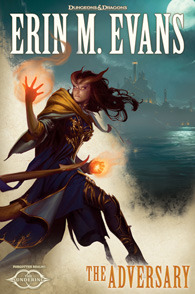The Adversary
by
Erin M. Evans (Goodreads Author)
In the 3rd book of the multi-author SUNDERING series kicked off by New York Times
best-selling author R.A. Salvatore, the award-winning Erin M. Evans
throws her signature character Farideh into a maelstrom of devilish
politics and magical intrigue. Captured by Netherese agents and locked
away in a prison camp, Farideh quickly discovers her fellow prisoners
are not simply enemies of Netheril, but people known as Chosen who
possess hidden powers, powers that Netheril is eager to exploit—or
destroy. As Farideh’s friends and sister race across the landscape on a
desperate rescue mission, Farideh is drawn deeper into the mystery of
the Netherese plot alongside two undercover Harper agents. But will her
closest ally turn out to be an adversary from her past?
My Rating: 9/10
Jonathan Armstrong
The third book in The
Sundering series, which aims to return the Forgotten Realms to a bit of
normalcy following some great turmoil, is a great read. Granted, there is not
much fighting, and no detailed combat like you would find in a book by R.A.
Salvatore, who kicked off the series. But there is power struggle, personal
struggle, the threat of violence at every turn, political manipulations to keep
readers (and characters) guessing, and refreshingly real characters.
I’ll be honest, the only reason this is not getting a 10/10
is that for the first third of the book, I was not nearly as invested. I was
wondering if this book was going to be a disappointment, and combined with the
second book of the series, wondering if any of the rest of the books in the
series (whose characters I also had never read about) would also not satisfy. The
reason was simple. There were too many characters to keep up with, and none to
really feel like you knew. This is
the danger with having a standalone novel that continues stories of several
characters of prior books, but I’m not willing to excuse it. I believe it is a
challenge, but not a necessary evil.
So what changed?
Easy. After about a third of the book, we stopped being introduced to
new characters via scenes that were often introductory soliloquies. Instead, we
got extended portions of text that focused on one character, or at most two or
three together, while they were moving the plot. With extended portions devoted
to a character or two or three, you got to get to know them, understand them,
and identify with them. Their interactions were revealing. History between them
naturally arose. How they reacted to events told us infinitely more about them
than their soliloquies.
And once we got to the plot of this story, it was tense to
the end. After reading about 45% of the book, I couldn’t put it down. I stayed
up into the morning reading when I haven’t done that in years. The plot was wonderfully
intriguing, and it always left you wondering how all the different parties
would play out. They were fractious on so many levels that I haven’t seen that
level of detail in even R.A. Salvatore’s work. No one seemed to be on the same
side or have the same motives completely.
Erin Evans made every character so real, it was incredible.
And that, in the end, is what made this book so amazing,
beyond even the plot. The characters. Every character was unique, no matter how
large or small their role. I was particularly fond of Farideh and Havilar, the
tieflings, because of how they reacted to each other as sisters and also seeing
the genuine portrayals of young women (err…tieflings) in them. As a side note,
I also really appreciated the view of sex here. It wasn’t taken lightly, and
the sister who did partake was still honest as a character since she tends to
be more passionate and reckless but not entirely stupid; she did so within a
relationship. When Farideh decided to resist Lorcan’s temptations and said she
should be praised for her “basic morals”, it was a great turn from what is the
current trend in our culture. Our current trend is represented by things like
“50 Shades of Grey” where a woman should give into the dark, seedy side of sex
instead of holding out for something pure and life-giving. It was greatly
refreshing, wherever Farideh eventually ends up on the issue (none of us are
perfect!).
Since there weren’t many scenes of violence in the book, I
thought I would mention that Erin Evans chose her moments selectively. Every
combat furthered a plot, changed a relationship, created an unexpected twist.
No violence for the sake of violence (even though I do enjoy a good R.A.
Salvatore battle scene). Honestly, I didn’t even notice the lack of violence
until this review, especially since the tension from the threat of violence
overhung everything. It was very well done and should not put anyone off from
this book.
I only hope that Erin Evans can learn from R.A. Salvatore in
how he introduces characters in each book (except for Drizzt’s journal entries,
please forego those). I first read “The Lone Drow” by Salvatore, the second
book of a trilogy and many books into his characters’ development, but didn’t
feel lost or uninvested. He introduced them through action and interaction,
with their thoughts interspersed between. I didn’t appreciate the difficulty of
that enough until I read books two and three of the Sundering.
The honesty and authenticity of Erin Evan’s characters alone
would have me wanting to read her past and future books, but combined with the
intricately woven plot, I have a new competitor for my favorite fantasy author.

No comments:
Post a Comment